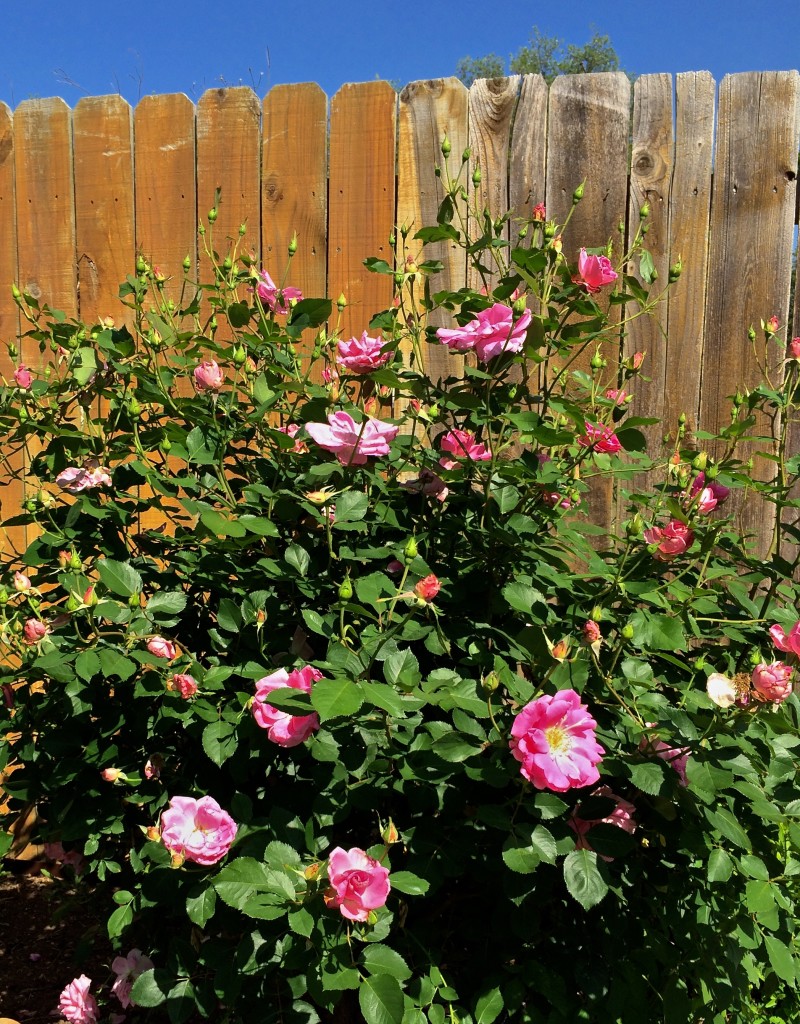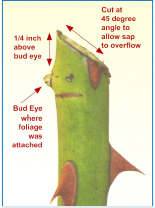
 Just as most plants in the garden are starting to shoot up, it’s time to whack back your roses. Oh no, you say, I couldn’t possibly do that. But if you want healthier plants and more prolific blooms, take your shears in hand.
Just as most plants in the garden are starting to shoot up, it’s time to whack back your roses. Oh no, you say, I couldn’t possibly do that. But if you want healthier plants and more prolific blooms, take your shears in hand.
It’s important to prune roses to reduce thin, weak or crowded stems and to increase airflow through the plant. Pruning off inward-facing canes improves circulation and helps prevent pests and diseases. Shaping the healthy stalks by cutting them back by one third or more helps maintain a compact plant.
 If you have climbers or one-time bloomers, wait until after they have finished their spring blooming because they bear flowers on last year’s wood. For continuous bloomers, a thorough spring pruning in Central Texas is usually done between the middle of February and the first week in March. Don’t worry if your rose has already sprouted growth, it’s still important to prune them now – they will reward you if you do. The ever-blooming varieties will then put on a show all summer because they bloom on new growth, which is prompted by pruning.
If you have climbers or one-time bloomers, wait until after they have finished their spring blooming because they bear flowers on last year’s wood. For continuous bloomers, a thorough spring pruning in Central Texas is usually done between the middle of February and the first week in March. Don’t worry if your rose has already sprouted growth, it’s still important to prune them now – they will reward you if you do. The ever-blooming varieties will then put on a show all summer because they bloom on new growth, which is prompted by pruning.
Make sure you sterilize your pruners with alcohol before you begin. This prevents the possible spread of any diseases. You’ll need to use curved-edge, scissor-like pruners, to prevent crushing the branches, and long handled loppers, and a pruning saw. You’ll also want to use long leather or extra thick rose gloves – sometimes I think those thorns actually reach out to grab me. I’ve found a great tool for pruning my roses — it actually grips the branch after it’s been cut. Then you simply release the handle and drop the branch into your brush bag without endangering your digits.
Hybrid Teas and Grandifloras
First, begin at the bottom and prune off any dead, old, brown or non-producing canes. Next, take out canes that are rubbing against or lying on other canes. Then cut stems that are growing in toward the center of the shrub. Cut off any growth of suckers at the base of the bush. Finally, cut remaining stems that are smaller than the diameter of a pencil.
The pruning and shaping cuts should be made at a 45-degree angle, about ¼ of an inch above a dormant bud, or eye, that is facing the outside of the plant. The eye looks like a small round and swollen bump on the branch and is not sprouting. Other, growing buds are already on their way to producing – pruning these dormant buds will promote more new growth and result in profuse blooms. The result should be a rose that is about two feet tall with about a half dozen canes.
Climbing roses
Climbing roses are pruned so as to encourage them to grow upward, instead of creating a compact bush. With these roses, trim as you would with Grandifloras, but allow more long, vertical canes to grow unless they are dead, unhealthy or are outgrowing their space. Then trim the horizontal side branches to about 5-10 inches, making sure the cut is above a bud eye and is aimed up at a 45-degree angle.
Floribundas and antique roses
These roses are generally not pruned as dramatically as the others. For these bushes, follow the same basic process, but cut fewer of the main canes off of the bush and prune only about 1/3 off the remaining healthy branches. For antique roses, you only need to remove the dead or crossed canes and give it a light pruning on last year’s growth. If they get too lanky, you can eliminate some of the older canes as needed.
Once pruning is complete, be sure to clean up and dispose of any leaves that have dropped around the base of the bush, just in case they contain fungi spores. Use a dormant spray, available at most independent nurseries, immediately after pruning. This will ensure that there are no remaining insects and fungi.
The American Rose Society recommends waiting 3-4 weeks before applying a rose fertilizer, but local sources recommend feeding right after the roses have been pruned. In our warm climate where the plants are already budding out, it should be safe to feed immediately after pruning.
And, as with all plants, apply an ample layer of mulch around the rose bush, being careful not to place the mulch right up to the base of the plant. This will prevent water evaporation, lessen the likelihood of weeds and protect the plant from extreme heat when the weather starts to warm up.
Local Landscape Designer and Garden Coach Diana Kirby provides landscaping tips at http:/www.dianasdesignsaustin.com and writes a garden blog at https://www.dianasdesignsaustin.com

